What are the benefits of Direct-To-Fabric printing?
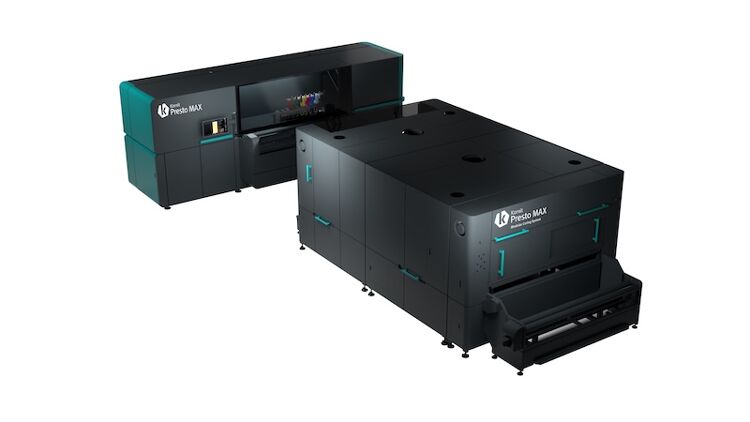
Direct-to-fabric printing is gaining popularity for high-volume textile production, enabling on-demand, customized short runs. These printers offer ink flexibility, accommodating various fabric types like cotton and silk, though ink development focuses on faster turnaround by reducing pre- and post-processing. Compared to traditional methods, direct-to-fabric inkjet printing is a more sustainable option due to reduced water and chemical usage, and localized production.
When it comes to textile printing, large format users have typically opted for either DtG, and more recently DtF, solutions to print direct to already made products like t-shirts, or they have chosen roll-fed dye sublimation printers to print to transfer papers. But high volume users have mostly taken a different route, using a roll-fed machine to print direct to fabric, allowing for short runs of customised patterns that can be produced on-demand.
Unlike most large format printers, which are designed to be used with a specific inkset, these direct to fabric machines are much more flexible in the inks that they will work with. This allows textile producers to run several machines of the same type, each with a different inkset for a particular class of fabric, such as cotton or silk. This brings advantages in having common workflows and maintenance routines, even though there may be some differences in the configuration of the machines and of the post press processes.
These inks are evolving rapidly as users demand faster turnaround times. Most fabric printing requires a number of different processes, often first laying down a primer for the ink, which has to be dried before printing. In many cases, following printing, the material has to be washed, perhaps steamed and maybe even ironed, all of which slows down the print process, undermining the fast turnaround nature of digital printing. The result is that newer inks require less after-print processing but users will have to check that the results deliver in terms of quality, hand-feel and longevity.
The last few years have also seen a push towards pigment inks that can print to almost any type of fabric, allowing a one-printer-fits-all solution. However, there are a number of practical difficulties to this. One issue is that the ink behaves differently on each type of substrate, which makes it necessary to use a pretreatment to control how the dots behave on each material type, but this adds an extra process.
Another problem is that the pigment inks sit on the surface of the fabric, rather than penetrating into the fibres and this produces a much rougher feel. Consequently some vendors feel that pigment printers are better suited to furnishings rather than apparel though others have added fabric softeners to improve the hand-feel.
What’s available?
There are too many of these printers to list them all here so we have for a brief survey of some of the most common models to illustrate the main features.
Kornit, which is perhaps best known for its DtG printers, also sells the roll-fed model Presto. This is a 1.8m wide machine that comes complete with an inline modular curing system. This curing unit can be configured with an extra heating unit to create the Max S solution, which allows for much quicker drying and therefore faster print speeds. The latest generation is the Presto Max, which runs Kornit’s latest pigment inkset, the NeoPigment Vivido. This ink is said to deliver deeper blacks and colours with lower ink usage and better hand-feel. The standard print speed is 90sqm/hr in Quality mode, or 140 sqm/hr in Production mode. These speeds double to 180 and 278 sqm/hr respectively with the Max S.
EFI’s Italian subsidiary Reggiani introduced a new printer last summer, the Reggiani Extra, which is available in both 1.8 and 3.4m widths.
It can print direct to most types of fabric, including cotton, silk, viscose, polyamide and wool, as well as to transfer paper. It can be used with a wide choice of inks, which includes reactive, disperse direct, acid, pigment and disperse sublimation. That makes it suitable for a number of applications, including apparel, home textile and sportswear.
The Extra has 12 colour channels, giving a choice of three configurations in total: up to 12 colours for better printing uniformity and colour depth; 6+6 colours for higher productivity; or 11 colours + chemistry for improved ink penetration into the fabrics and better fastness.
The printheads are 600dpi Kyocera KJ4B EX600 RC, complete with recirculation. Micol Gamba, EFI Reggiani’s product marketing director, says that Reggiani opted for the 600dpi heads rather than 1200 dpi, explaining: “We have tested 1200 dpi print heads in the past, and our experience is that the benefit we can get on fabrics is not so evident for the characteristics of the substrate. That’s why we stayed with the 600 dpi version. We’d see a big difference instead if we should print on a different substrate like paper.”
Epson makes a number of large format textile printers as part of its SureColor-F series. But the heavy duty direct to fabric printers come under its Monna Lisa brand. There are several of these, starting with the entry level ML8000, which uses eight 1200 dpi PrecisionCore printheads, and going up to the ML64000 with 64 of these heads. The workhorse models are the ML16000 and ML32000, with 16 and 32 heads respectively, which both offer eight colour channels.
Epson offers a choice of inks from its Genesta brand, which includes Acid, reactive, disperse and pigment.
The Indian manufacturer ColorJet showed off a new Earth 32i direct to fabric printer at last year’s Fespa show in Amsterdam. There are three models in the original Earth series – Earth 8, 16 and 32 – with the names denoting the number of heads used. The heads themselves are Konica Minolta KM1024i.
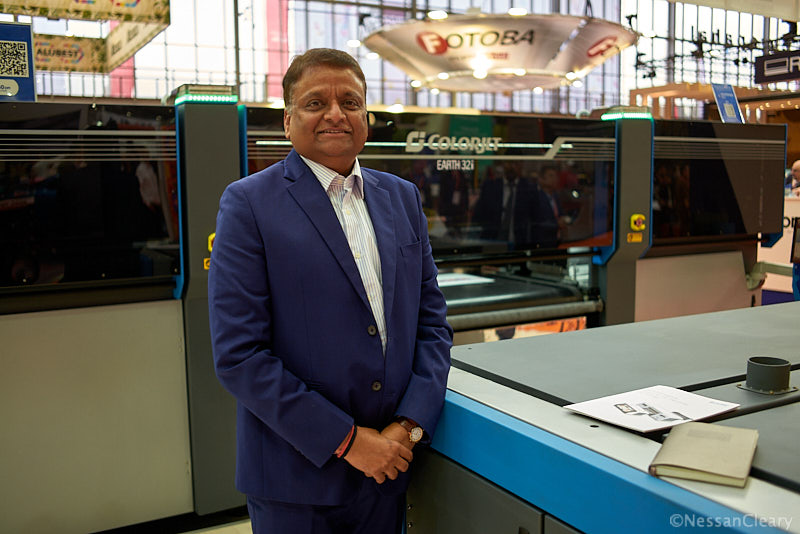 Madhu Sudan Dadu, chairman of Colorjet with the Earth 32i. ©Nessan Cleary.
Madhu Sudan Dadu, chairman of Colorjet with the Earth 32i. ©Nessan Cleary.
The standard Earth machines use reactive inks while the 32i uses pigment ink. Madhu Sudan Dada, chairman of Colorjet, says that this makes for a more sustainable solution, noting: “Less water and less energy and less chemicals. This is more suitable for the European market. India is more into reactive inks because they produce high volumes and the running cost is very important. In India it’s more about the productivity and the price.”
Naturally there are also a number of Chinese made direct to fabric printers. One of the leading Chinese brands is Atexco, which sells several models including the Vega X1, which is now also available in Europe.
It uses Kyocera heads with 600 dpi resolution. There’s a choice between eight or 16 heads and it can be configured with up to eight colour channels. It can run pigment, reactive, acid or disperse inks and customers can choose which colours, or even to double up on CMYK for faster speeds. Enrico Ciotti, president of ECD SRL, who is responsible for the installations, servicing and ink supplies in Europe, says that most customers use inks from SPG Prints, and mainly use acid, reactive and sublimation inks. Atexco offers an optional vision system that can enure accurate front to back registration and can adjust the printing to take account of the stretchiness of the fabric.
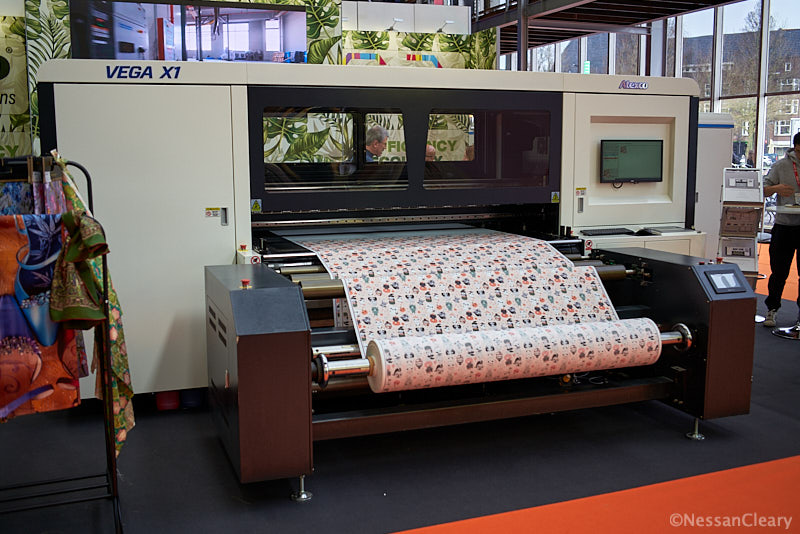 Atexco sells this Vega X1 textile printer. ©Nessan Cleary.
Atexco sells this Vega X1 textile printer. ©Nessan Cleary.
Finally, it’s also worth noting that using inkjet machines to print direct to fabric is far more sustainable than conventional production methods for textile printing. Inkjet production uses less water, and results in far less pollution. It also allows fabrics to be produced closer to the final manufacturers, which cuts down on transport costs and allows for more efficient production with less overall waste, so we are likely to see continuing growth in this market area.
Discover the latest innovations in textile printing, substrates and dtf printing at FESPA Global Print Expo 2025, Europe's leading print and signage exhibition taking place from 6 - 9 May at Messe Berlin, Germany. It will showcase the most innovative products, visionary concepts, and latest developments in the future of print. Register to visit here and use promo code FESJ502 and pay only 25 euros for your entrance ticket.
Interested in joining our community?
Enquire today about joining your local FESPA Association or FESPA Direct
Recent news
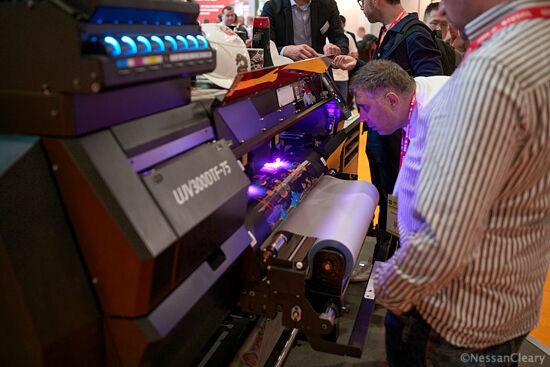
The latest innovations in DTF printing
The Direct-to-Film (DTF) market is experiencing significant growth, with major printers now offering dedicated solutions. Beyond the traditional textile applications, there's a notable expansion into UV DTF technology, allowing for heat-free application to various objects. This evolution, alongside advancements from companies like Epson, Roland, Brother, and Ricoh, indicates DTF's continued diversification and increasing appeal for diverse printing needs.
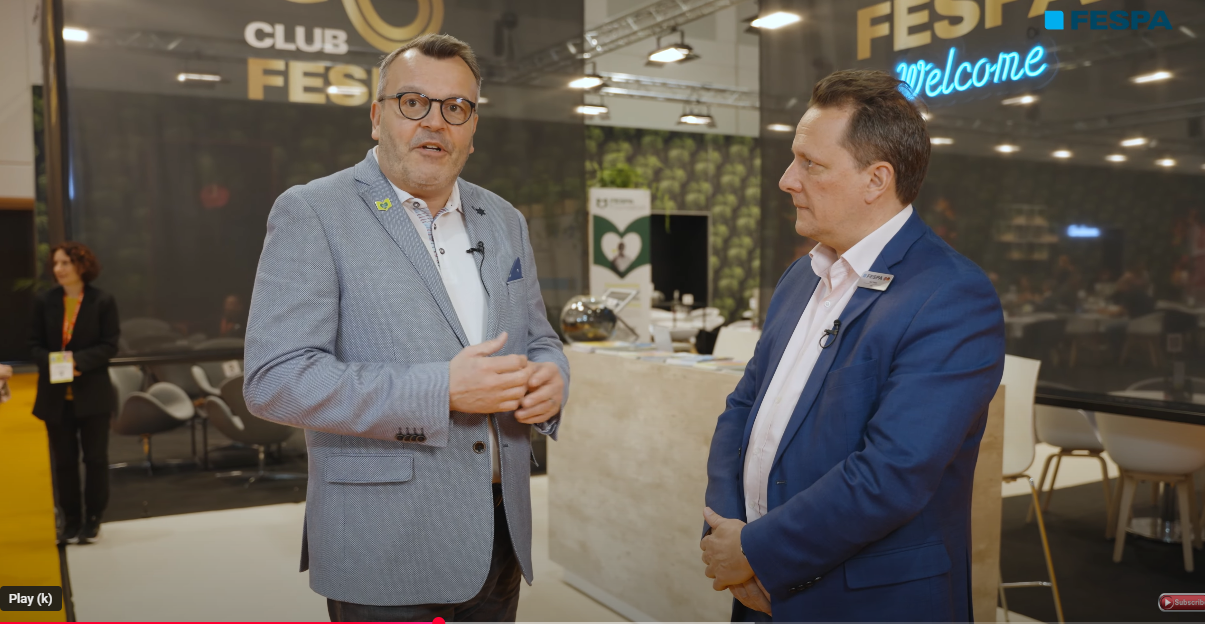.png?width=550)
Personalisation Experience 2025 - Overall Highlights
Personalisation Experience 2025 saw the meeting of global visionaries exploring the opportunities of smart manufacturing and personalisation in print through on-demand digital technologies.
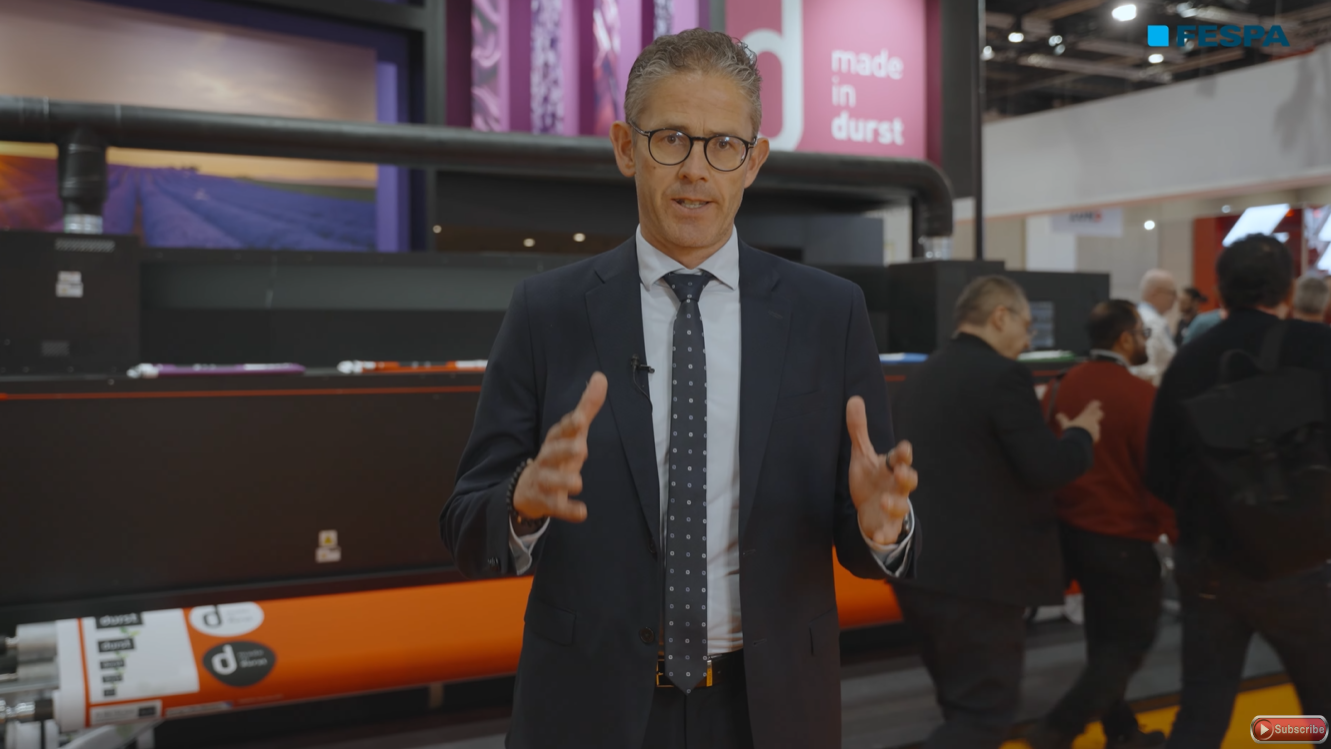.png?width=550)
How to streamline 5-meter textile printing with the Durst P5 500 Tex iSub
We speak to Christian Harder, VP of Sales at Durst at the FESPA Global Print Expo 2025 in Berlin.
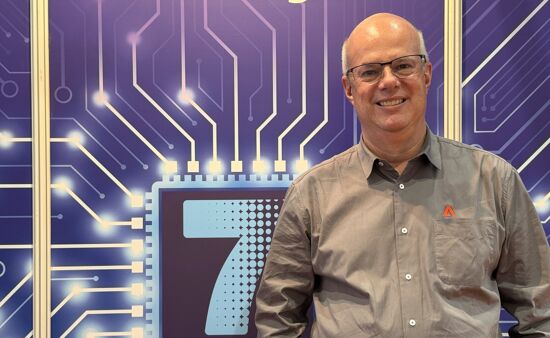
Exploring the latest update to the Adobe PDF Print Engine 7 with Mike Scrutton of Adobe
In this conversation, Debbie McKeegan, Fespa Textile Ambassador and Mike Scrutton of Adobe discuss the latest innovations in textile printing, focusing on Adobe's PDF print engine 7 update and its impact on the industry.